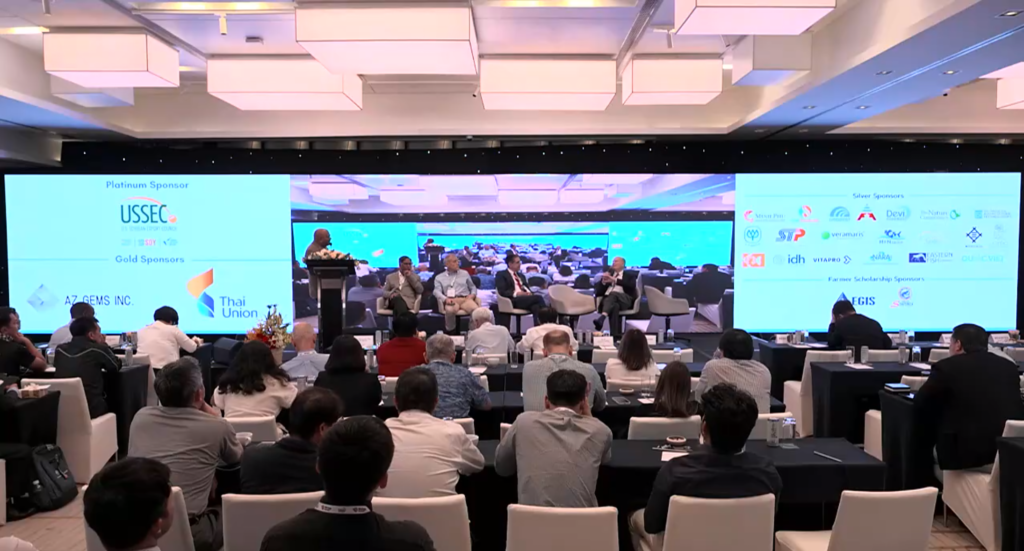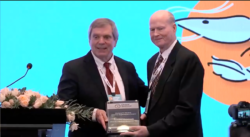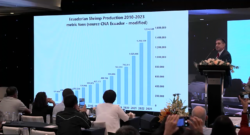
News & Views
Industry Update
Breeding
shellfish
Shrimp
Shrimp Summit takes deep dive into industry challenges
TCRS's inaugural event in Vietnam gathers global shrimp farming experts to tackle issues faced by industry
July 27, 2023 By Jean Ko Din
 A screenshot of the livestream on Shrimp Breeding at the 2023 Shrimp Summit in Ho Chi Minh City, Vietnam on July 24-26. (Photo: The Center for Responsible Seafood)
A screenshot of the livestream on Shrimp Breeding at the 2023 Shrimp Summit in Ho Chi Minh City, Vietnam on July 24-26. (Photo: The Center for Responsible Seafood) Shrimp farming is something that can make poor men rich and rich men poor. But, Robins McIntosh said it is passion that drives the business.
McIntosh was named an honoree of a Lifetime Achievement Award at the inaugural Global Shrimp Summit. In his keynote address, he shared about his lifetime in the industry and how he has seen the passion that drove him and his colleagues to keep going “even though maybe logic says we shouldn’t.”

TCRS President George Chamberlain presents Robins McIntosh with Lifetime Achievement Award at 2023 Shrimp Summit. (Photo: The Center for Responsible Seafood)
“I think it’s one of the hardest jobs you can do. And it really has created a brotherhood around the world,” said McIntosh, CEO of Homegrown Shrimp USA and executive vice-president of Charoen Pokphand Group Co., Ltd.
The 2023 Global Shrimp Summit took place on July 24-26 at the New World Saigon Hotel in Ho Chi Minh City, Vietnam. The event was also available to about 360 virtual attendees on the event website.
The industry event was organized by TCRS, a non-profit organization dedicated to becoming a global hub for knowledge sharing, applied research and collaborative programs for the seafood industry. The Shrimp Summit is co-hosted by the Global Seafood Alliance (GSA), the Vietnam Department of Fisheries, the Vietnam Fisheries Society (VINAFIS), and the International Collaborating Centre for Aquaculture and Fisheries Sustainability (ICAFIS).
TCRS president, George Chamberlain, said the event welcomed about 300 in-person attendees, including international seafood buyers, technical experts, NGO representatives, government officials and producers. As global demand for farmed seafood increases, he said there is a growing need for the industry to come together to create sustainable solutions.
“In my mind’s eye, I could imagine every session drawing to the ultimate conclusion, and we would know the road map, but of course, that’s unrealistic in one hour,” said Chamberlain at the closing address of the event. “The thing that I think is crucial is to follow up. We need to not lose the momentum.”
From sustainable feeds, improver programs, investment and innovations, many topics were discussed during the three-day event.
McIntosh joined a panel discussion of fellow experts deriving key differences between shrimp breeding programs in Ecuador and Asia. He presented on the merits of specific pathogen-free (SPF) breeding and farming, which is a method that he attributes to the “Asian Shrimp Revolution” that began in 2000.
“Once (the SPF method) was installed, it was a straight line up for survival rates,” he said.
But as the Asian industry faces major biosecurity concerns, McIntosh was asked about India as an example of whether genetics and breeding can be harnessed to take on these challenges. He explained that the mortalities many Indian farmers face cannot only be solved through genetics, it’s also the level of pathogens in the farms.
“I can’t send my animals to India,” he said during a panel. “The levels have built up to very high levels. If you reduce your levels and stock at lower densities, and I’ve talked to Indians that have done this, they are successful.”
In comparing Ecuador’s mass selection method to the SPF model, McIntosh added that the path forward for the Asian industry might not be in either method, but in first applying lower density systems.
“Yes, you can select for basically anything with the right model,” added John Buchanan, CEO of the Center for Aquaculture Technologies. “I think it’s important to note that production’s accommodation of health management, nutrition, husbandry and genetics, I don’t think genetics is the only solution. And it wouldn’t be instantaneous.”
In his presentation, Buchanan explained the advantages and disadvantages of many shrimp breeding methods. Looking to the salmon industry, he said genomic selection method is gaining popularity in shrimp farming and could be the next step.
“Genomics coming on board can really speed those processes up and make more gains per generation, at a cost. So, you need to make sure that you understand the return on investment and it’s not a burden,” Buchanan said.

João Rocha, an Ecuadorian geneticist with Texcumar and AQuest, presented data from CNA Ecuador that showed the rapid growth of the country’s shrimp production. (Photo: The Center for Responsible Seafood)
João Rocha, an Ecuadorian geneticist with Texcumar and AQuest, presented data from CNA Ecuador that showed the rapid growth of the country’s shrimp production from 2010 to present day. It also showed in the first half of this year, the country had already produced 18 per cent more than the previous year.
“This is a success in production, but in terms of the economy of production, you know very well that with this excess of production, the prices went down,” said Rocha.
The shrimp market around the world has been experiencing rapid growth in production. Allan Cooper, Vitapro business and value creation director, explained that while shrimp production grows stronger, the current market demand is lagging. Cooper said if the industry wants to drive further growth, companies must build demand and “be N.I.C.E.”
“Narratives that highlight benefits. Innovation towards new usages. Consumption trends that build momentum. Education for first-timers to refute misconceptions,” he said, explaining the acronym.
Cooper presented examples in other food production industries, like avocados and milk, to share marketing strategies that employed these principles. Short-term profits could come from encouraging current consumers to eat more shrimp, while long-term profits will rely on incentivizing newcomers and engaging with new markets.
Print this page
Advertisement
- Charting the fish’s journey from egg to plate
- Stolt Sea Farms to expand its land-based flatfish hatchery





